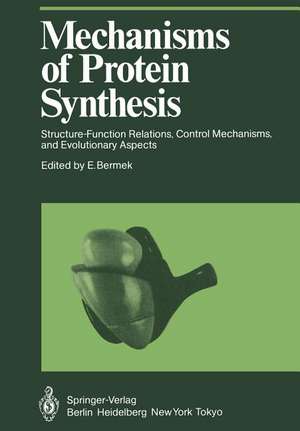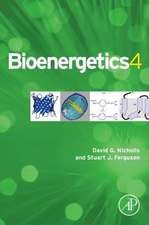Mechanisms of Protein Synthesis: Structure-Function Relations, Control Mechanisms, and Evolutionary Aspects: Proceedings in Life Sciences
Editat de E. Bermeken Limba Engleză Paperback – 6 dec 2011
Din seria Proceedings in Life Sciences
- 15%
 Preț: 646.75 lei
Preț: 646.75 lei - 18%
 Preț: 952.26 lei
Preț: 952.26 lei - 15%
 Preț: 637.28 lei
Preț: 637.28 lei - 18%
 Preț: 960.61 lei
Preț: 960.61 lei - 15%
 Preț: 648.24 lei
Preț: 648.24 lei - 15%
 Preț: 632.70 lei
Preț: 632.70 lei - 15%
 Preț: 654.43 lei
Preț: 654.43 lei - 15%
 Preț: 635.80 lei
Preț: 635.80 lei - 18%
 Preț: 959.50 lei
Preț: 959.50 lei - 15%
 Preț: 650.37 lei
Preț: 650.37 lei - 15%
 Preț: 636.45 lei
Preț: 636.45 lei - 15%
 Preț: 644.49 lei
Preț: 644.49 lei - 15%
 Preț: 641.53 lei
Preț: 641.53 lei - 15%
 Preț: 664.61 lei
Preț: 664.61 lei - 5%
 Preț: 721.77 lei
Preț: 721.77 lei - 15%
 Preț: 652.49 lei
Preț: 652.49 lei - 5%
 Preț: 592.63 lei
Preț: 592.63 lei - 15%
 Preț: 636.80 lei
Preț: 636.80 lei - 15%
 Preț: 646.43 lei
Preț: 646.43 lei - 15%
 Preț: 649.22 lei
Preț: 649.22 lei - 18%
 Preț: 1390.11 lei
Preț: 1390.11 lei - 18%
 Preț: 956.33 lei
Preț: 956.33 lei - 15%
 Preț: 643.48 lei
Preț: 643.48 lei - 15%
 Preț: 641.38 lei
Preț: 641.38 lei - 15%
 Preț: 642.03 lei
Preț: 642.03 lei - 15%
 Preț: 640.24 lei
Preț: 640.24 lei - 15%
 Preț: 651.34 lei
Preț: 651.34 lei - 15%
 Preț: 649.39 lei
Preț: 649.39 lei - 5%
 Preț: 714.06 lei
Preț: 714.06 lei - 15%
 Preț: 640.37 lei
Preț: 640.37 lei - 15%
 Preț: 664.11 lei
Preț: 664.11 lei -
 Preț: 492.59 lei
Preț: 492.59 lei - 18%
 Preț: 945.47 lei
Preț: 945.47 lei - 15%
 Preț: 647.73 lei
Preț: 647.73 lei - 18%
 Preț: 942.01 lei
Preț: 942.01 lei - 18%
 Preț: 943.57 lei
Preț: 943.57 lei - 15%
 Preț: 639.41 lei
Preț: 639.41 lei - 5%
 Preț: 726.15 lei
Preț: 726.15 lei - 15%
 Preț: 641.03 lei
Preț: 641.03 lei - 5%
 Preț: 707.33 lei
Preț: 707.33 lei - 15%
 Preț: 647.27 lei
Preț: 647.27 lei - 15%
 Preț: 638.57 lei
Preț: 638.57 lei - 15%
 Preț: 645.79 lei
Preț: 645.79 lei - 15%
 Preț: 654.12 lei
Preț: 654.12 lei - 15%
 Preț: 652.31 lei
Preț: 652.31 lei - 18%
 Preț: 946.72 lei
Preț: 946.72 lei - 15%
 Preț: 637.28 lei
Preț: 637.28 lei - 5%
 Preț: 718.46 lei
Preț: 718.46 lei - 15%
 Preț: 653.33 lei
Preț: 653.33 lei
Preț: 639.08 lei
Preț vechi: 751.86 lei
-15% Nou
Puncte Express: 959
Preț estimativ în valută:
122.30€ • 132.80$ • 102.73£
122.30€ • 132.80$ • 102.73£
Carte tipărită la comandă
Livrare economică 22 aprilie-06 mai
Preluare comenzi: 021 569.72.76
Specificații
ISBN-13: 9783642699146
ISBN-10: 3642699146
Pagini: 236
Ilustrații: X, 222 p.
Dimensiuni: 170 x 244 x 12 mm
Greutate: 0.38 kg
Ediția:Softcover reprint of the original 1st ed. 1985
Editura: Springer Berlin, Heidelberg
Colecția Springer
Seria Proceedings in Life Sciences
Locul publicării:Berlin, Heidelberg, Germany
ISBN-10: 3642699146
Pagini: 236
Ilustrații: X, 222 p.
Dimensiuni: 170 x 244 x 12 mm
Greutate: 0.38 kg
Ediția:Softcover reprint of the original 1st ed. 1985
Editura: Springer Berlin, Heidelberg
Colecția Springer
Seria Proceedings in Life Sciences
Locul publicării:Berlin, Heidelberg, Germany
Public țintă
ResearchCuprins
Ribosome Structure.- RNA Structure, Free and on the Ribosome, as Revealed by Chemical and Enzymatic Studies.- Studies of E. coli Ribosomes Involving Fluorescence Techniques.- Ribosomal Components of the Peptidyl Transferase Center.- Elongation Factor Tu Interactions.- Interaction Between Elongation Factor Tu and Aminoacyl-tRNA.- Recognition of Aminoacyl-tRNA by Bacterial Elongation Factor Tu.- Transfer RNA Binding to Ribosomes.- tRNA Binding to and Topographical Arrangement on E. coli Ribosomes.- Ribosomal Translocation.- Studies on Structural Dynamics of the Translating Ribosome.- Proof-Reading in Translation.- The Effect of “In Vivo” Incorporation of ?-Aminobutyric Acid into E. coli Proteins.- Regulation of Eukaryotic Chain Initiation.- A Direct Correlation Between the Affinity of a Given mRNA for Eukaryotic Initiation Factor 2 and its Ability to Compete in Translation.- Regulation of Initiation Factor Activity.- Translational Control of Protein Synthesis in Reticulocyte Lysates by eIF-2? Kinases.- Calcium Ions and Phospholipid Activate a Translational Inhibitor in Reticulocyte Lysates.- High pO2 -Promoted Activation of a Translational Inhibitor in Rabbit Reticulocytes: Role of the Oxidation State of Sulfhydryl Groups.- Eukaryotic Chain Elongation.- Guanine Nucleotide Binding to Eukaryotic Elongation Factor 2: A Possible Control Mechanism of Eukaryotic Chain Elongation.- Evolution and Selective Action of Translational Inhibitors.- Some Interesting Features of a Halobacterial Gene and its mRNA.- Cell Evolution and the Selective Action of Translation Inhibitors.- Concluding Remarks.







